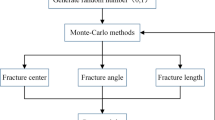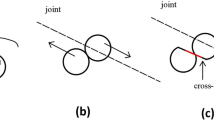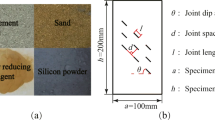Abstract
The generation of nonpersistent joints in numerical specimens is not easy to achieve in some geotechnical numerical software. In this paper, the synthetic rock mass modeling method was used to construct a group of numerical specimens based on triangular grain-based model and random joint set (RJS) model in universal discrete element code. The randomly distributed nonpersistent joints have seven dominant inclination angles. Then the unconfined compressive strength (UCS) tests of the seven groups of specimens were carried out numerically to obtain some insight into the influence of dominant inclination angle on strength behaviors, failure modes and fracture development. The inclination angles of the nonpersistent RJS have fluctuant effect on the UCS of the specimens. The maximum UCS appeared when the RJS angle is 90°, and small UCS values appeared when the RJS angles are 45°, 60° and 75°. With decreasing RJS angle, the brittleness gradually changes into ductility, and strain hardening occurs. During the whole uniaxial compression process, shear fractures take the dominant role during the preliminary stage and then reduce gradually, while the tensile fractures have an inverse variation trend during the initial stage and significantly increase when the axial strain exceeds 0.6% and then keeps growing until the compression ending. The nonpersistent RJSs with small and large angles have little contribution to the shear fracture development, and only the RJSs with median inclination angles (45°, 60°) significantly promote the shear fracture propagation and development, while the RJS makes an increasing contribution to the tensile fracture propagation and development with the increase in the RJS inclination angle.

















Similar content being viewed by others
References
Liu, R.C.; Jiang, Y.J.; Li, B.; Wang, X.S.: A fractal model for characterizing fluid flow in fractured rock masses based on randomly distributed rock fracture networks. Comput. Geotech. 65, 45–55 (2015)
Lei, Q.H.; Latham, J.P.; Tsang, C.F.: The use of discrete fracture networks for modelling coupled geomechanical and hydrological behavior of fractured rocks. Comput. Geotech. 85, 151–176 (2017)
Vazaios, I.; Farahmand, K.; Vlachopoulos, N.; Diederichs, M.S.: Effects of confinement on rock mass modulus: a synthetic rock mass modelling (SRM) study. J. Rock Mech. Geotech. Eng. 10(3), 436–456 (2018)
Sharif, L.K.; Elmo, D.; Stead, D.: Improving DFN-geomechanical model integration using a novel automated approach. Comput. Geotech. 105, 228–248 (2019)
Wang, C.L.; Zhang, C.S.; Li, Y.; Zheng, C.: Numerical investigation of the mechanical properties of coal masses with T-junctions cleat networks under uniaxial compression. Int. J. Coal Geol. 202, 128–146 (2019)
Yang, X.X.; Jing, H.W.; Chen, K.F.: Numerical simulations of failure behavior around a circular opening in a non-persistently jointed rock mass under biaxial compression. Int. J. Min. Sci. Technol. 26(4), 729–738 (2016)
Saadat, M.; Taheri, A.: A numerical approach to investigate the effects of rock texture on the damage and crack propagation of a pre-cracked granite. Comput. Geotech. 111, 89–111 (2019)
Chong, Z.H.; Li, X.H.; Hou, P.: Experimental and numerical study of the effects of layer orientation on the mechanical behavior of shale. Arab. J. Sci. Eng. 44(5), 4725–4743 (2019)
Kazerani, T.; Zhao, J.: A microstructure-based model to characterize micromechanical parameters controlling compressive and tensile failure in crystallized rock. Rock Mech. Rock Eng. 47(2), 435–452 (2014)
Tan, X.; Konietzky, H.; Chen, W.: Numerical simulation of heterogeneous rock using discrete element model based on ditital image processing. Rock Mech. Rock Eng. 49(12), 4957–4964 (2016)
Tan, X.; Konietzky, H.: Numerical study of variation in Biot’s coefficient with respect to microstructure of rocks. Tectonophysics 610(5), 159–171 (2014)
Jiang, S.Q.; Li, X.; Tan, Y.Q.; Liu, H.H.; Xu, Z.Q.; Chen, R.: Discrete element simulation of SIC ceramic with pre-existing random flaws under uniaxial compression. Ceram. Int. 43(16), 1–27 (2011)
Turichshev, A.; Hadjigeorgiou, J.: Development of synthetic rockmass bonded block models to simulate the behaviour of intact veined rock. Geotech. Geol. Eng. 35(1), 313–335 (2017)
Farahmand, K.; Vazaios, I.; Diederichs, M.S.; Vlachopoulos, N.: Investigating the scale-dependency of the geometrical and mechanical properties of a moderately jointed rock using a synthetic rock mass (SRM) approach. Comput. Geotech. 95, 162–179 (2018)
Ma, C.; Yao, W.M.; Yao, Y.; Li, J.: Simulating strength parameters and size effect of stochastic jointed rock mass using DEM method. KSCE J. Civ. Eng. 22(12), 4872–4881 (2018)
Ma, W.Q.; Wang, T.X.: Instability mechanism and control countermeasure of a cataclastic roadway regenerated roof in the extraction of the remaining mineral resources: a case study. Rock Mech. Rock Eng. 52(7), 2437–2457 (2019)
Tang, C.A.; Tham, L.G.; Wang, S.H.; Liu, H.; Li, W.H.: A numerical study of the influence of heterogeneity on the strength characterization of rock under uniaxial tension. Mech. Mater. 39(4), 326–339 (2007)
Daphalapurkar, Nitin P.; Ramesh, K.T.; Graham-Brady, L.; Molinari, J.F.: Predicting variability in the dynamic failure strength of brittle materials considering pre-existing flaws. J. Mech. Phys. Solids 59(2), 297–319 (2011)
Ma, W.Q.; Wang, T.X.: Compression failure characteristics and crack propagation of brittle rock under confining pressures. Chin. J. Rock Mech. Eng. 37(4), 898–908 (2018)
Acknowledgements
This research is financially supported by the Key Scientific Research Projects of Higher Education Institutions in Henan Province (Grant No. 20A560019), the Nanhu Scholars Program of Xinyang Normal University and the Natural Science Foundation of China (Grant No. 41807240). The author gratefully acknowledges the financial support provided by them.
Author information
Authors and Affiliations
Corresponding author
Rights and permissions
About this article
Cite this article
Ma, W., Wang, T. Numerical Study of the Influence of Joint Angle on the Failure Behavior of Randomly and Nonpersistently Jointed Rock Mass. Arab J Sci Eng 45, 4023–4036 (2020). https://doi.org/10.1007/s13369-020-04361-5
Received:
Accepted:
Published:
Issue Date:
DOI: https://doi.org/10.1007/s13369-020-04361-5




